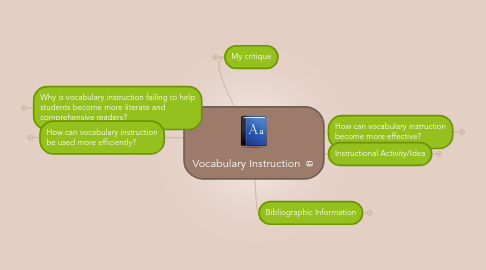
1. Why is vocabulary instruction failing to help students become more literate and comprehensive readers?
1.1. Traditional method problems
1.1.1. Definitional approach: Simply having students memorize definitions can lead to a superficial level of work knowledge and comprehension when the word is used in a text.
1.1.2. Contextual approach: Having students learn vocabulary through textual context is a problem because often times context does not supply adequate information to know the meaning of the word.
1.2. Partial word knowledge
1.3. Lack of indepth word knowledge: leads to difficulty with reading comprehension
1.4. Lack of understanding texts with unfamiliar words: leads to difficulty with reading comprehension
2. How can vocabulary instruction be used more efficiently?
2.1. Know that students can understand a certain amount of unknown words without their comprehension being disrupted. Realize that you do not need to give intensive instruction on every unfamiliar word in the text for your students to comprehend the reading.
2.2. Intensive vocabulary instruction is not always necessary because through reading students can discover the meanings of unfamiliar words. Having your students read regularly can be a source for vocabulary instruction
2.3. Simply giving your students the definition of a word does not ensure that they will comprehend it. Use context and minimal instruction to help them decode and understand.
3. My critique
3.1. Lots of good solutions to vocabulary instruction problems but not many practical examples as to how a teacher could implement them
3.2. Did not limit vocabulary instruction to Language Arts but to all areas of study where students will encounter unfamiliar vocabulary.
3.3. Clearly states the problems and solutions to make the instruction more effective and efficient
3.4. Included helpful charts and graphic organizers to show what different activities could look like.
3.5. I appreciated that Nagy emphasized the great need for more reading in the classroom to help increase vocabulary comprehension
4. How can vocabulary instruction become more effective?
4.1. Integration: vocabulary instruction is structured so that it integrates and relates words to other information
4.1.1. Semantic mapping ('brainstorming')
4.1.1.1. Semantic feature analysis: deals with relationships among word meanings
4.1.1.2. Hierarchical arrays: representation of relationships among word meanings
4.1.1.3. Linear arrays: represents relationships among words by arranging them in a line
4.1.2. Emphasis on concepts: vocabulary instruction must have students come along to understand new concepts. For example, discuss the meaning or concepts of a word without mentioning the name of the word.
4.2. Repetition: For a reader to read well, they must be adept at decoding and recognizing words. Students not only need to know what the word means but also should have had sufficient practice to easily recognize and understand the word when reading.
4.3. Meaningful use: students will learn more if they are more actively involved, have practice to deeply process words, and feeling confident and able to use the word.
5. Instructional Activity/Idea
5.1. The "AIM" Game: pre-reading sequence that will help make students' reading of something more interesting and insightful
5.1.1. 1. Associating Ideas - A brainstorming activity where small groups play two word-association games from words related to a theme chosen from the text they will read (90 seconds to make the list)
5.1.1.1. Prepares students for reading because it has them creating their own vocabulary lists of words related to a theme.
5.1.2. 2. Ideas that Match - Relationship making exercise where groups use the two lists generated from above, make pairs of words by matching a word from one list to another from the other list. They should be abel to support why the two words matched up make sense together.
5.1.2.1. Prepares students for reading because they use their thinking skills to pair different vocabulary words together that were associated with a theme.
5.1.3. 3. My Opinion, Your Opinion - Discussion game where students agree or disagree with five 'opinion statements' based on the theme.
5.1.3.1. Prepares students for reading because the students discuss their own views and ideas on the theme that the author of the text will bring up and vocabulary that might be included with it.
